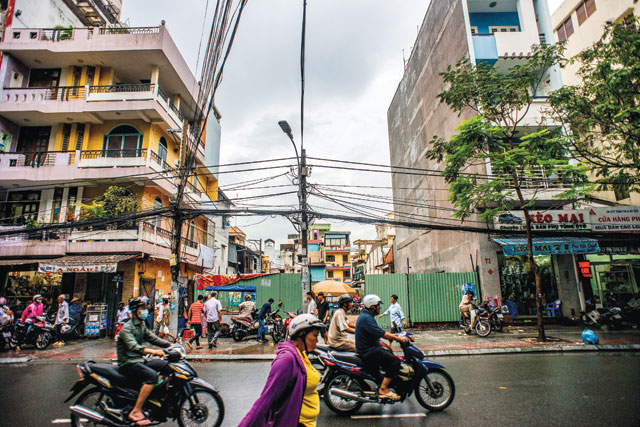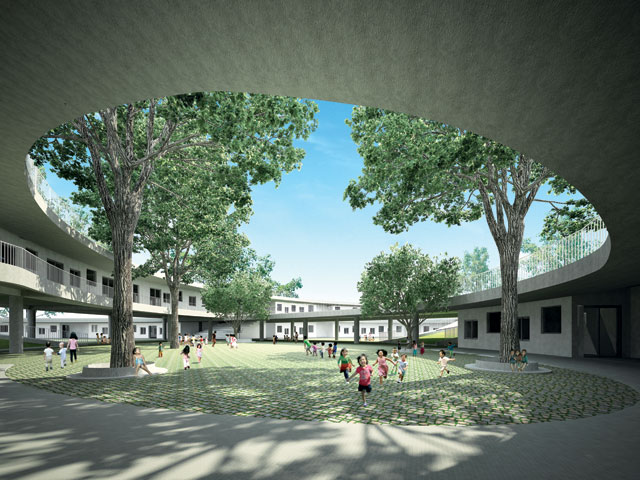Green architecture is not entirely new to Vietnam, but it had been forgotten. The practice can be a universal win: for developers, inhabitants and the environment. Green buildings are designed to efficiently use energy, utilising passive design to enhance airflow and buffer the sun. They are said to improve the quality of human life while maintaining the ecosystem’s capacity at local and global levels. They look pretty, often with splashes of green vegetation spilling over their edges. They also attract premium prices.
French colonial buildings in Ho Chi Minh City were not built with green intentions – they were built to last and for comfort. Louvered shutters provided ventilation, while wide, covered verandas gave insulation and shade, making interiors comfortably cool. Similar techniques have made a sustainable comeback in Singapore and Malaysia, and show tentative signs of a reawakening in Vietnam.
Unfortunately, more recent developers shunned passive design in favour of building quickly and cheaply.
“Vietnam’s rapid urbanisation has contributed to this, as has the demand to maximise living space in multi-generational homes with many people sharing them,” said Hannah Jefferys, an architect based in Ho Chi Minh City.

Following this method, thickened walls for insulation, buffer zones and gardens are deemed wastes of space, according to Hieu Nguyen, administration and communication officer for the Vietnam Green Building Council (VGBC). Buildings designed to be air conditioned 24 hours a day are also a problem. “Fully glassed buildings are fashionable but soak up too much solar heat and consume a lot more energy for cooling” Nguyen said.
Of course, it is important to be up to date in the construction industry, but Jefferys said that Vietnam’s version of this often entails “superficial mimicking of what is seen in the West, without knowledge of the modern and efficient practices behind the design”.
Modern building design is not adapted to Vietnam’s climate.
Hieu Nguyen
Enter the VGBC. Established in 2007, and officially endorsed by the government since 2008, it is a member of the World Green Building Council – which aims to “raise awareness and build capacity for the development of green building”. According to Nguyen, the VGBC is beginning to influence the attitudes of budding architects via training modules at major Vietnamese universities and by offering internships to worthy students.
However, the council’s biggest contribution thus far is Lotus, a set of rating tools for green buildings similar to Singapore’s Green Mark or the US’s prestigious Leadership in Energy and Environmental Design (Leed). Vietnam required bespoke benchmarks: Its market-driven economy run by a communist government makes for a unique regulatory environment, while its climatic mixed bag – from the muggy Mekong Delta to the chilly mountains of Dalat – adds further confusion.
“[The rating system] makes up for some flaws in Vietnam’s existing building regulations,” said Jefferys, herself a graduate of the VGBC’s three-day Lotus accreditation course. “It encourages accessibility, so new developments don’t pop up on virgin land in the middle of nowhere, as well as natural disaster mitigation, especially flooding, which is a huge problem in Vietnam exacerbated by a void of building regulations dealing with it.”
However, only four buildings have been certified and ten registered into the certification process. Compare that number to Singapore, where 1,800 buildings are listed with Green Mark, or Malaysia, where more than 500 are registered on the country’s Green Building Index.

Last year, Fairventure Worldwide, a German consultancy organisation, published a report examining sustainability awareness in Vietnam’s construction sector. The report found that 58% of people surveyed – most of them architects in Hanoi – always consulted clients about energy efficiency and green building solutions, but most clients declined to participate in the Lotus system. The high initial investment and limited awareness of the benefits of green buildings were two of the main reasons for dismissing greenification.
Lotus certification adds between 5% and 15% to a project’s costs, although there are numerous other reasons for building green, according to Tham Kai Wai, marketing manager for Singapore’s Green Building Council.
“The benefits of green buildings include cost savings from efficient use of energy and water – leading to lower operation and maintenance costs – as well as enhancements to occupants’ health and productivity,” she said. “These are received by different stakeholders throughout the building’s lifecycle.”
Nevertheless, Jefferys has an arduous time convincing developers to fork out now for benefits that will come later. “Vietnamese developers are not in the habit of thinking long term, and they are sceptical of sustainability concepts,” she said.
One factor that will drive demand for energy-efficient building is the rising cost of electricity. In November last year, the government gave Electricity Vietnam permission to raise prices by 7-10% every six months. The move represented a continued hike in power costs: Since December 2011, prices have increased by 5% on four occasions.

While the government has also passed a series of laws promoting energy efficiency, the VGBC laments the lack of clear incentives for developers to build green, as well as clear punishments for those violating the few standards that are in place. Again, this stands in stark contrast to Singapore’s official stance on sustainability – where dozens of schemes are in place covering everything from greenhouse gas management to green shipping, and repeat litterers can be fined up to SGD5,000 ($3,950).
The opportunity for self-marketing appears to be the one aspect of green architecture that is most taking developers’ fancy. President Place in Ho Chi Minh City, a new 13-floor office building, is testament to this – the “Leed Gold certified” banner proudly displayed on its exterior is impossible to miss. The building used the US green rating system Leed because its construction started before the inception of Lotus. According to the VGBC, either certification will “enhance brand value, increase occupancy rates and ultimately attract premium rental fees”.
While some developers have taken the marketing opportunities afforded by green certification to heart, they seem less keen on its ethics. Jefferys has heard of developers asking: “How much?” to pass Lotus’s criteria. Such companies and developers are immediately blacklisted by Lotus.
“Many developers use green as a marketing ploy, although the sales factor will wear off eventually, whereupon they will move on to another marketing ploy,” said Ken Yeang, Malaysia’s famed eco-architect and partner at TR Hamzah & Yeang architects. “Meanwhile, the devastations of our society on the environment continue needing to be addressed.”


